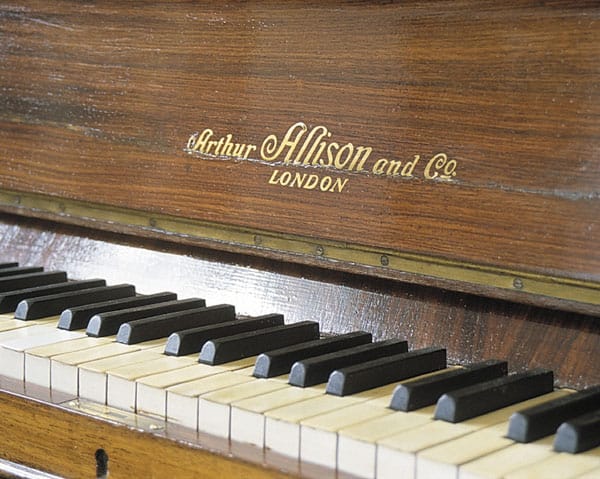The Royal Navy piano has kept its good looks and its even, symphonic tone, even though it hasn't been tuned for more than 78 years-not since before it was set aboard the HMS Raleigh, the one-time flagship of the British Atlantic Squadron.
An ornate emblem found in the upright's interior proclaims it a "Great English Piano." And so it is. A dignified, durable product of the Arthur Allison and Company of London, England, it stands proudly in the living room of Rita and Cecil Davis' Lighthouse Cove Bed and Breakfast, in L'Anse-Amour, Labrador. The top of the piano is usually covered with framed black and white prints that pay silent homage to the Raleigh and her crew. The instrument was left behind by the ship's captain, a man named Bromley, and was handed down to the Davises by Cecil's late parents, William and Isabella. It's likely to be handed down again some day, this time to Rita and Cecil's daughter, Lisa.

The piano's proud stance is in direct contrast to the Raleigh herself. The Cavendish class light cruiser lies in pieces, strewn over several hundred feet of shoreline on the Labrador coast. The vessel was ordered blown to smithereens by the British Admiralty in 1926. The Raleigh had run aground on August 8, 1922. For four embarrassing years, she was the subject of curiosity and mockery amongst mariners making their way through the Labrador Straits as she sat cheerlessly on the rocks at Point Amour, stripped piece by piece by salvagers until all that was left was a mere shell of short-lived glory. The bulk of the Raleigh now rests in about 15 metres of water. You can touch chunks of steel bigger than cars, small nuts and bolts and strips of the Raleigh's hull that, today, make for one of Atlantic Canada's most novel beachcombing expeditions, each piece emitting tell-tale orange rust that stains the palms of curiosity-seekers.
On this illustrious July 2000 morning, a humpback has been frolicking so close to shore in waters nearby that it seems to be auditioning for a role in a Nature of Things segment. Cecil Davis works to refinish the belly of his dory, which is at drydock in his yard. Even he, who has lived on this cove all his life, is astonished at the daring proximity of the beast and concerned over the whale possibly beaching itself.
Inside the Davis home, where things are tame and orderly, a pony-tailed composer from Barrie, ON, lightly and confidently fingers arpeggios on the "Great English Piano." Music fills the B&B and spills out onto the rocky shore, entertaining the gulls and, no doubt, enticing the whale. The young composer and his musician spouse have just finished Rita Davis' hale and hearty breakfast and are on their way to the Baroque Festival in Lameque, NB. They are sure to relate the tale of the piano and its place of beauty when they return to friends in Ontario.
The cove that houses this community is fringed by a dirt road which twists and turns for four kilometres, winding past the earliest known Maritime archaic Indian burial mound, past a white-sand beach as inviting as PEI's Cavendish, and past the teensy cluster of houses which includes the Davis'. The road unveils the Point Amour Lighthouse. The second highest in Canada, the 10-storey tower of stone prominently casts its light for 16 seconds, then eclipses for four seconds in perpetual cycles as it surveys the narrowest point in the straits between Labrador and Western Newfoundland. L'Anse-Amour is one of the smallest in a necklace of tiny inlet communities strung along the Southern Labrador coast, places with names like L'Anse au Clair, L'Anse au Diable, L'Anse au Loup, L'Anse au Cotard and L'Anse a Denis. There's also Red Bay, nearby site of the prolific Basque whaling industries of the 1500s, where there's many more a shipwreck. Still, the Raleigh is unique amongst them all.
 At four o'clock on that fateful August afternoon in 1922, Isabella Davis was outside, tending to the cows. Through the "black thick of fog," she heard the crunching and grinding of the Raleigh as it drifted at high speed onto the limestone and granite rockbed not 200 yards from the lighthouse, tearing a gash some 360 feet long in her hull. The event was an affront to the esteemed lighthouse and its piercing fog whistle, and enough to make the British military wince in anguish. The Raleigh, after all, was not engaged in heroics nor even in military exercises. Her captain was intent on Forteau Bay, determined to cast a line in the Forteau River in his personal quest for trout and salmon. As it turned out, the only lines that were eventually cast that day were in attempts to save men's lives. All but 11 of the Raleigh's crew of 700 men were saved. Most of the names of the fated appear today on a grave marker in a humble cemetery along the L'Anse-Amour Road.
At four o'clock on that fateful August afternoon in 1922, Isabella Davis was outside, tending to the cows. Through the "black thick of fog," she heard the crunching and grinding of the Raleigh as it drifted at high speed onto the limestone and granite rockbed not 200 yards from the lighthouse, tearing a gash some 360 feet long in her hull. The event was an affront to the esteemed lighthouse and its piercing fog whistle, and enough to make the British military wince in anguish. The Raleigh, after all, was not engaged in heroics nor even in military exercises. Her captain was intent on Forteau Bay, determined to cast a line in the Forteau River in his personal quest for trout and salmon. As it turned out, the only lines that were eventually cast that day were in attempts to save men's lives. All but 11 of the Raleigh's crew of 700 men were saved. Most of the names of the fated appear today on a grave marker in a humble cemetery along the L'Anse-Amour Road.
Some 605 feet in length, the Raleigh carried a host of armaments, including huge guns and torpedoes, on her trip. To lighten the on-board military mood, she also carried the handsome Arthur Allison piano, a pump organ and silver tea services. Furniture, brass and copper fixtures and a plethora of other Raleigh memorabilia are found today in the homes of people up and down the coast, stashed by ancestors who hosted the stranded sailors. The men were plucked away by the CPR passenger ship SS Montrose and the HMS Calcutta over the weeks that followed the grounding. Only then did life at L'Anse-Amour get back to normal, although the Raleigh's much-appreciated disposal of several 40-gallon wooden kegs of West Indian rum reportedly made that local Christmas one of the most memorable but poorly recollected in history.
Captain Bromley stayed on at the Davis home until nearly November, managing to maintain some military decorum and discipline among his crew. He reportedly conducted roll call every morning in an effort to keep track of his men, raising them from their temporary shelters in tents, from the bottom to the top of the lighthouse, from the lighthouse's various outbuildings and from residents' homes. While the grounding of the Raleigh likely did not do much to advance his career, Bromley was not the first British Navy commander said to have been lured to the Forteau River for salmon. The sinking of the Raleigh was preceded in 1889 by the downing of another British warship, the HMS Lily, whose captain is said to have had similar angling intentions along the local coast.
In 1997, a 75th anniversary commemoration of the sinking of the Raleigh was held in communities near Point Amour. A re-enactment was held on the grounds of the Davis' Lighthouse Cove B&B. From inside the home, the Great English Piano was played under amplification to the participants and spectators outside. One of the renditions heard that afternoon was a popular Newfoundland hymn, "Will Your Anchor Hold?"
"Will your anchor hold in the storm of life?
When the clouds unfold their wings of strife
When the storm tides lift and the cables strain
"Will your anchor drift or firm remain?"
The Great English Piano now patiently awaits the talents of future guests at Rita and Cecil's B&B, wishing and hoping to once again play the typical mess hall tunes that once entertained captain and crew of the Raleigh as she plowed the waves of the Atlantic.
If you go:
The Lighthouse Cove Bed and Breakfast, L'Anse-Amour, NF (709) 927-5690
